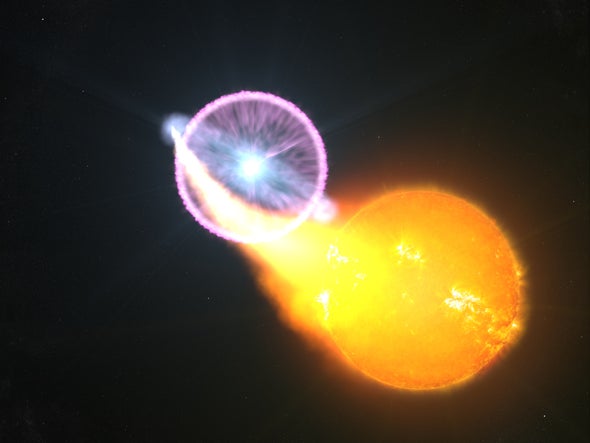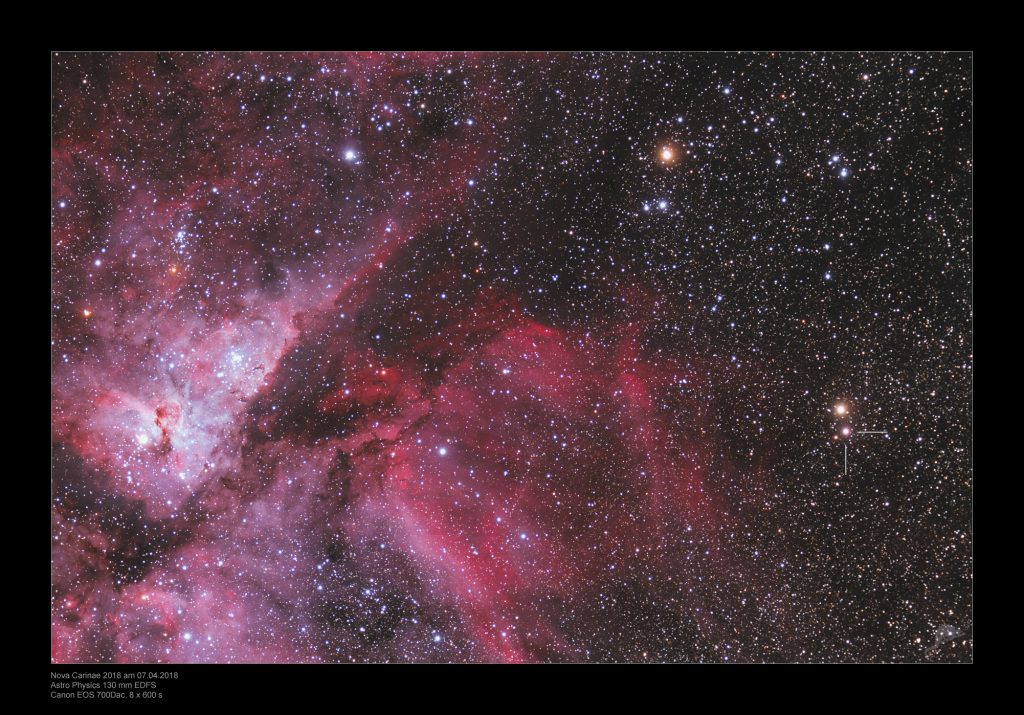Seeing the light: Professor Anthony Moffat and an international team of astronomers find new way novae light up the sky
A nova, or stella nova the Latin word for “new star,” is an explosion which occurs on the surface of a star. The explosion produces an incredible amount of energy resulting in an increase in the star’s brightness by thousands or even millions of times. Sometimes a nova is so bright that it appears as a new naked-eye star, a star that is suddenly there where there wasn’t one before. Thus, the name nova.

Artist’s portrayal of a classical nova explosion. Credit: S. Wiessinger, NASA’s Goddard Space Flight Center.
These novae occur in stars called white dwarfs, which are part of a binary system; that is, two stars orbiting one another. What happens is the white dwarf strips material from the companion star, and this material piles up on the white dwarf’s surface where the density becomes so high that it undergoes an explosive nuclear fusion.
While for many years, astronomers have thought that nuclear burning of material on the surface of the white dwarf directly powers all the light from the explosion, more recently astronomers started debating that “shocks” from the explosion might power most of the brightness.
Now, an international team of researchers, among which Professor Anthony Moffat from Université de Montréal and member of the Centre for Research in Astrophysics of Quebec (CRAQ), has found that it is indeed shocks that cause most of the nova’s brightness. The research is detailed in a paper published in the journal Nature Astronomy titled “Direct evidence for shock-powered optical emission in a nova.”
“This is a new way of understanding the origin of the brightness of novae and other stellar explosions,” said Elias Aydi, a research associate in Michigan State University’s Department of Physics and Astronomy and lead author of the paper. “Our findings present the first direct observational evidence, from unprecedented space observations, that shocks play a major role in powering these events.”
So, what are shocks and how do they form? Picture a supersonic jet airplane. When the jet exceeds the speed of sound, it produces a shock which leads to a loud sonic boom. In a nova explosion, the shocks produce light rather than sound. When material blasts out from the white dwarf it is ejected in multiple phases and at different speeds. These ejections collide with one another and create shocks, which heat the ejected material producing much of the light.
Another side effect of astronomical shocks are gamma-rays, the highest-energy kind of electromagnetic radiation. The astronomers detected bright gamma-rays from the star, known as nova V906 Carinae (ASASSN-18fv), whose explosion in the constellation Carina was first detected in March 2018.

A real image of nova V906 Carinae (right-center) taken at the Onjala observatory. Credits: Franz Hofmann & Wolfgang Paech – the Chameleon and Onjala observatory.
Using NASA’s Fermi Gamma-ray Space Telescope, they showed that V906 Car had the brightest gamma-rays ever observed for a nova, proving that it hosts energetic shocks.
But the real surprise came because an optical satellite – one of the six nanosatellites that make up a collection of satellites operated by an international consortium called the BRITE constellation of cube-sats – just happened to be looking at the part of the sky where the nova occurred. Comparing the gamma-ray and optical data, the astronomers noted that every time there was a fluctuation in gamma-rays, the light from the nova fluctuated as well. This means that both emissions are originating from shocks and that shocks are indeed responsible for most of the brightness of the event.
“I’m especially impressed at the synergy between two entirely different approaches to reveal something entirely new, like here the correlated shocks in gamma and optical, with surprisingly little coming in X-rays, all observed simultaneously from space,” said Professor Moffat. “The BRITE-Constellation mission is one of the cheapest astronomical satellite projects ever conceived and first realized by a collaboration among Canadian, Austrian and Polish astronomers, resulting in such a precious discovery, even if serendipitous,” he added.
The team estimates that V906 Car is about 13,000 light years from Earth. This means that when the nova was first detected in 2018, it had actually happened 13,000 years ago.
This new information may also help explain how large amounts of light are generated in other stellar events, including supernovae and stellar mergers, when two stars collide with one another.
URL of paper: https://www.nature.com/articles/s41550-020-1070-y
Contact:
Prof. Anthony Moffat
Université de Montréal
moffat@astro.umontreal.ca
Source:
Robert Lamontagne
Media relation and public outreach
Centre de recherche en astrophysique du Québec
Phone: (438) 495-3482
lamont@astro.umontreal.ca
